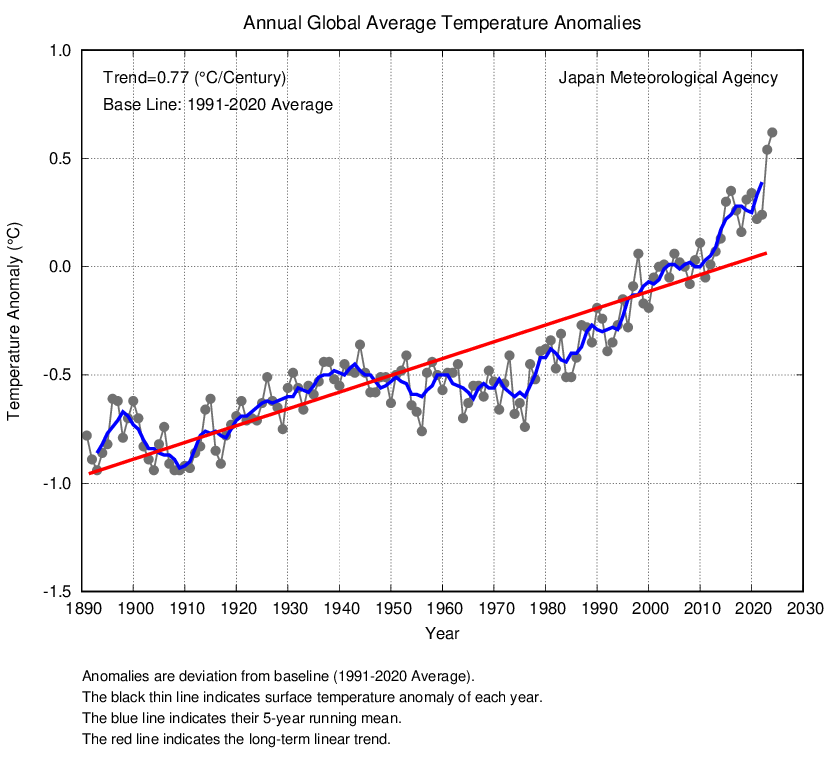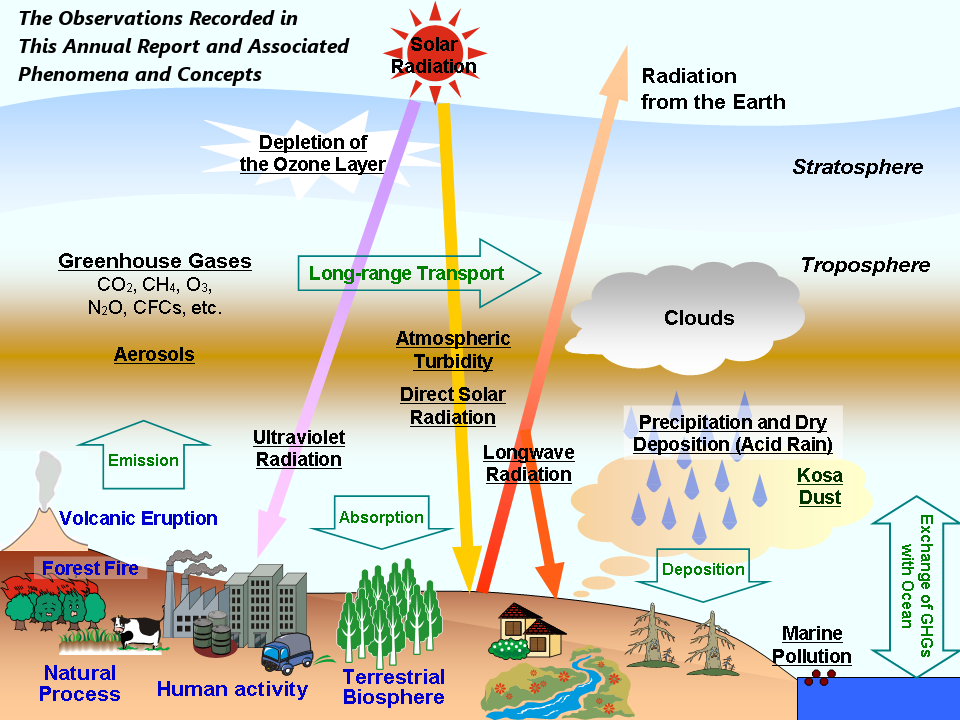| Recent years have seen growing concern over world environmental issues such as global warming, ozone layer depletion and acid rain as well as extreme weather events associated with climate change. These phenomena are expected to seriously impact socio-economic activity and the natural environment around the world. To address the related issues, JMA carries out various types of observation, monitoring and research, and provides the results to individual National Meteorological and Hydrological Services, other relevant organizations and the academic community of the world through international frameworks including WMO. |
|
JMA contributes to the development of mitigation and adaptation measures related to climate change in various sectors through the provision of scientific information and expertise on climate change. For this purpose, JMA monitors and analyzes climatic conditions in Japan and around the world as well as greenhouse gas concentrations and global average sea surface temperatures. The Agency publishes the results of numerical projections for future climate conditions to assess the effects of global warming. JMA contributes to international collaboration for the purpose of assessing climate change, particularly through the activities of the Intergovernmental Panel on Climate Change (IPCC), by preparing assessment reports. |
 Changes in annual surface temperature for the end of the 21st century (2076 – 2095 average) relative to the end of the 20th century (1980 – 1999 average) (picture from Climate Change in Japan The 2020 edition) |
 Time series of monthly mean atmospheric CO2 concentrations observed at JMA's observatories |
 Long-term trend of global average surface temperature |
|
Atmospheric and Marine Environment Monitoring Data include all global environment-related observations made by the Japan Meteorological Agency (JMA). These data include measurements of atmospheric and marine greenhouse gases, ozone depleting substances, the ozone layer, ultraviolet radiation, aerosols, solar radiation, precipitation and dry deposition, and marine pollution. |
 Phenomena and Concepts Covered by the Report |
|
JMA monitors global climate data through WMO's Global Telecommunication System (GTS). It assembles quality-checked data on temperature and precipitation to assess extreme climate events, and releases World Climate on such phenomena with brief descriptions of the resulting disastrous conditions. The Agency also monitors the present state of the global climate system. These monitoring results are useful in understanding the present climate, including extreme events and long-term trends, and in carrying out long-range forecasts and scientific research. |
 Distribution of Extreme Climate Events |
|
JMA carries out monitoring of greenhouse gases, aerosols, solar radiation, ozone layer and ultraviolet radiation, and provides related information under WMO's Global Atmosphere Watch (GAW) program. JMA operates the World Data Centre for Greenhouse Gases (WDCGG) to archive related information and provide greenhouse gas observation data from all over the world via the Internet as part of GAW activities. Its global analysis work supports the publication of annual WMO Greenhouse Gas Bulletins, providing important scientific information to the United Nations Framework Convention on Climate Change (UNFCCC). JMA also operates the Quality Assurance/Science Activity Centre (QA/SAC), the World Calibration Centre (WCC) and the Regional Dobson Calibration Centre (RDCC). The work of these centres helps to improve the observation of carbon dioxide, methane and total ozone in Asia and the South-West Pacific. |
 Global environment observation network Global environment observation network |
|
Japan started Antarctic observation as an activity related to the International Geophysical Year (IGY) in 1957/1958. Since the first Japanese Antarctic Research Expedition in 1957, JMA has sent experts to Antarctica every year to conduct observation of ozone and solar radiation as well as surface and upper-air at Syowa Station. Observation conducted at this station led to the discovery of the ozone hole over Antarctica, and it still plays an important role in monitoring the global environment and climate. |
 Fundamental observation building, Syowa Station (69°00’S 39°35’E) and Antarctic ozone hole in October 2023 (gray area), based on NASA satellite data. Fundamental observation building, Syowa Station (69°00’S 39°35’E) and Antarctic ozone hole in October 2023 (gray area), based on NASA satellite data. |
|
JMA conducts various kinds of oceanographic and marine meteorological observation with a view to ensuring safety and economic ship routing, preventing marine disasters and providing data for climate change monitoring. This observation is carried out using research vessels, drifting buoys, profiling floats, tidal stations, coastal wave stations and earth-observing satellites. |
|
JMA operates two research vessels in the western Pacific including the seas adjacent to Japan. These vessels mainly monitor large-scale, long-term variations in ocean environments, including global warming, in cooperation with international observation programs such as the IOCCP (International Ocean Carbon Coordination Project). Main purpose of the observation is to clarify increase in temperature of deep water, anthropogenic CO2 storage in interior of ocean and acidification of ocean. Observation data from vessels are essential for accurate projection of global warming as well as analysis of current oceanic conditions. JMA also receives marine meteorological reports from merchant and fishery vessels via INMARSAT free of charge under WMO's VOS (Voluntary Observation Ship) scheme. - Reference materials for marine meteorological obsevation - Observations by Research Vessels - Oceanic carbon cycle |
 JMA research vessel (Ryofu Maru) Click the above photo to view more research vessels. |
 Ocean data buoy and Argo float |
JMA deploys drifting ocean data buoys in the seas adjacent to Japan to perform autonomous observation of atmospheric pressure, sea waves and water temperature as they drift on the sea surface. For sub-surface observation using floats, JMA participates in the Argo Project, which is conducted under WMO, UNESCO/IOC and other related institutions. As part of the project, JMA deploys profiling floats to observe water temperature and salinity from the sea surface to a water depth of 2,000 m. It also operates the Japan Argo Data Assembly Center to enable distribution of the resulting data for international exchange. - Ocean Data Buoy Observations |
|
In order to monitor unusual sea-level changes such as storm surges and tsunamis, which can cause devastating damage to coastal areas, JMA observes sea levels at tidal stations located along the coast of Japan. In addition to tidal stations, the Agency also has coastal wave stations to observe wave heights and wave periods for safe marine transport and safety management of buildings in coastal areas. |
|
Based on the types of observation outlined above, JMA provides a variety of oceanographic information, such as data on variations and long-term trends of sea surface temperature (SST), sea current and sea-level change and sea ice. Since El Niño and La Niña events are related to climate variability in various regions of the world, JMA monitors and predicts El Niño Southern Oscillation (ENSO). Monthly diagnostic reports, including ENSO monitoring products, ENSO indices and El Niño outlooks, are published using the results. - State of the ocean climate - El Niño Monitoring and Outlook |